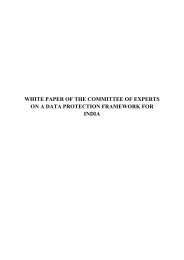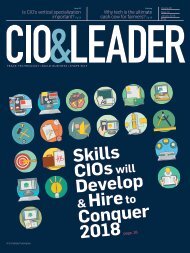CIO & LEADER-Issue-01-April 2018 (1)
Create successful ePaper yourself
Turn your PDF publications into a flip-book with our unique Google optimized e-Paper software.
Insight<br />
Origin of breaches<br />
TThe conversation around enterprise<br />
security and threat management has<br />
always been horizontal. While there<br />
is a broader recognition today that the<br />
business impact of an incident could<br />
vary significantly across industries,<br />
there has been little effort to understand<br />
how the fundamental metrics of<br />
threat vary across businesses.<br />
That means a largely uniform, horizontal<br />
approach towards security.<br />
The recently released Verizon<br />
Data Breach Investigations Report<br />
(DBIR) 2<strong>01</strong>8 — the 11th edition of the<br />
study — reveals why that could be<br />
awfully inadequate.<br />
Whether it is in terms of the origin<br />
(external vs internal) of breach/<br />
incidents, the type of data breached<br />
or the nature of the attacks, the nine<br />
industries covered by DBIR 2<strong>01</strong>8 show<br />
significant difference. Some of those<br />
metrics are key to the understanding<br />
of the nature of threats and hence<br />
important from the point of view of a<br />
solutions approach.<br />
For ex<strong>amp</strong>le, as much as 99% of the<br />
breaches occur in the accommodation<br />
(hospitality) industry involve external<br />
factors, while in healthcare, as much as<br />
56% are internal. In fact, in hospitality,<br />
Point of Sales (PoS) accounts for 90%<br />
of all breaches.<br />
“Often restaurants are smaller organizations<br />
without the luxury of trained<br />
security staff, but they are forced to<br />
rely almost exclusively on payment<br />
cards for their existence,” explains the<br />
report. These attacks are overwhelmingly<br />
motivated by financial gain and<br />
perpetrated by organized crime.<br />
100%<br />
90%<br />
80%<br />
70%<br />
60%<br />
50%<br />
40%<br />
30%<br />
20%<br />
10%<br />
0%<br />
Accommodation<br />
100%<br />
90%<br />
80%<br />
70%<br />
60%<br />
50%<br />
40%<br />
30%<br />
20%<br />
10%<br />
0%<br />
Accommodation<br />
Education<br />
Education<br />
Financial<br />
Financial<br />
Healthcare<br />
The differences are not just in the origin.<br />
The motives too are significantly<br />
different across industries. Though<br />
increasingly, financial motives are<br />
becoming predominant, in some<br />
areas—like manufacturing and public<br />
administration—espionage are almost<br />
equally strong motives. In healthcare,<br />
curiosity is a major factor.<br />
The kind of data that is targeted also<br />
vary across industries. In Accommodation,<br />
93% of compromised data is payment<br />
data; in education, 72% of data<br />
is personal. Credentials account for a<br />
huge 41% in the Information sector.<br />
A good counter-threat strategy<br />
requires that the breaches are<br />
Information<br />
Manufacturing<br />
External Internal Others<br />
Prof Services<br />
Motive behind breaches<br />
Healthcare<br />
Information<br />
Manufacturing<br />
Prof Services<br />
Public Administration<br />
Public Administration<br />
Financial Espionage Convenience Fun ideology others<br />
Retail<br />
Retail<br />
understood clearly. Each industry<br />
has a different mix of motives, origins<br />
and the kind of data that is targeted.<br />
Since the security budget and<br />
resources are limited, they need to be<br />
channelized properly to optimize the<br />
effectiveness of the security strategy.<br />
Depending on the nature of<br />
threat, the companies will not just<br />
be able to identify the investment<br />
priorities, it may also help an entire<br />
industry segment to come together<br />
to minimize certain threats. In<br />
areas like healthcare and public<br />
administration, a collaborative<br />
approach may be more effective than<br />
siloed approach<br />
<strong>April</strong> 2<strong>01</strong>8 | <strong>CIO</strong>&<strong>LEADER</strong><br />
33














